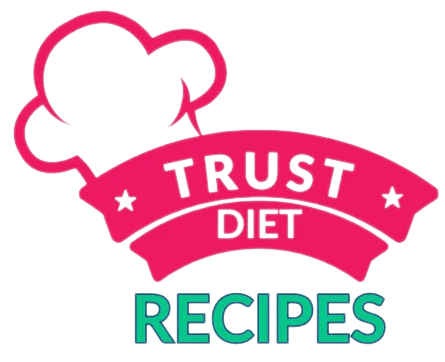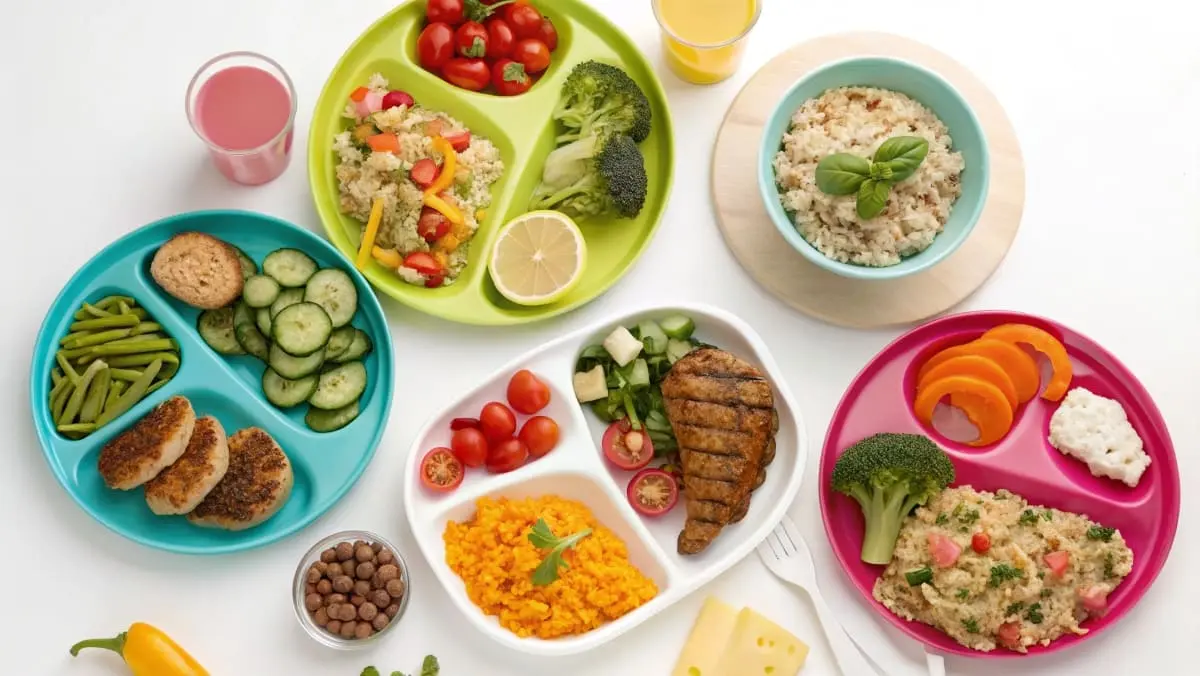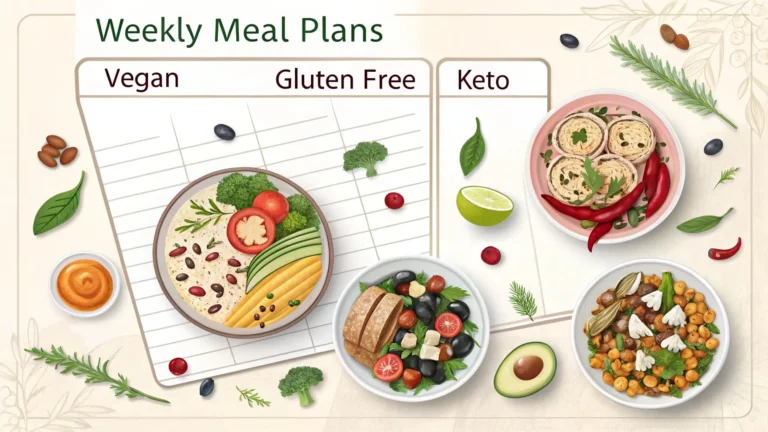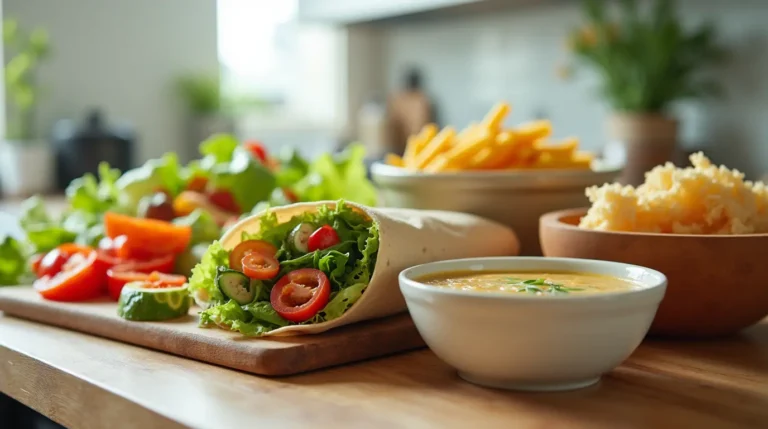Kid Friendly Recipes: Best Meals for Special Diets
Making Special Diets Delicious & Fun for Kids!
Feeding kids can be challenging enough, but when you add special dietary needs into the mix, mealtimes can feel downright overwhelming. Are you a parent navigating food allergies, intolerances, celiac disease, or other dietary restrictions for your child? Do you worry about how to make sure your child is eating safely and enjoying their meals? Are you tired of feeling limited by “restricted” recipes that are bland, difficult to make, or simply not appealing to kids?
You’re not alone! Many parents face the daily challenge of providing nutritious and delicious meals while managing special diets for their children. It can feel like a constant balancing act between health, safety, and kid appeal. The grocery store aisles can seem daunting, recipe books can feel restrictive, and the fear of accidental allergen exposure can be ever-present.
But guess what? Special diets for kids do not have to mean sacrificing flavor, fun, or ease! In fact, with the right approach and recipes, you can create incredibly delicious, kid-friendly meals that are safe, nutritious, and enjoyable for all children, regardless of their dietary needs.
This article is your ultimate guide to creating kid friendly recipes for special diets. We’ll explore the key principles, provide a wealth of mouthwatering recipe ideas catering to common dietary restrictions, share essential tips for success, and show you how to make special diet cooking feel less like a burden and more like an empowering and creative culinary adventure. Get ready to transform mealtimes from a source of stress into a celebration of delicious, safe, and inclusive food for your kids!
Table of Contents
Understanding Common Special Diets for Kids (Brief Overview)
Before we dive into the recipes, let’s briefly understand some of the most common special diets that parents navigate for their children. It’s important to remember that every child’s needs are unique, and consulting with a pediatrician or registered dietitian is always recommended for personalized dietary advice. However, understanding the basics of these diets can empower you to make informed choices and adapt recipes effectively.
Gluten-Free Diet (Celiac Disease & Gluten Sensitivity):
A gluten-free diet is essential for children with celiac disease, an autoimmune disorder triggered by gluten, and for those with non-celiac gluten sensitivity. Gluten is a protein found in wheat, barley, and rye.
- Why Gluten-Free? For children with celiac disease, consuming gluten damages the small intestine and prevents nutrient absorption. For those with gluten sensitivity, gluten can cause various uncomfortable symptoms. A strict gluten-free diet eliminates these issues.
- Foods to Avoid: Common gluten-containing foods include wheat bread, pasta, most conventional cereals, many baked goods (cakes, cookies, crackers), and gluten can be hidden in processed foods, sauces, and condiments. Always read labels carefully!
- Gluten-Free Alternatives: Fortunately, there are many delicious gluten-free alternatives available! Gluten-free grains like rice, quinoa, corn, oats (certified gluten-free), and gluten-free flour blends can be used to create delicious and satisfying meals.
Dairy-Free Diet (Dairy Allergy & Lactose Intolerance):
A dairy-free diet is necessary for children with a cow’s milk allergy or lactose intolerance.
- Why Dairy-Free? Cow’s milk allergy is a common food allergy in children, where the immune system reacts to milk proteins. Lactose intolerance is the inability to digest lactose, a sugar found in milk, causing digestive discomfort.
- Foods to Avoid: Dairy includes milk, cheese, yogurt, butter, cream, ice cream, and whey and casein (milk proteins often found in processed foods). Read labels carefully for hidden dairy ingredients.
- Dairy-Free Alternatives: Many delicious dairy-free alternatives are readily available! Dairy-free milks (almond milk, soy milk, oat milk, coconut milk), dairy-free cheeses (made from plant-based sources), dairy-free yogurts (coconut yogurt, almond yogurt), and dairy-free butter alternatives can be used in cooking and baking.
Nut-Free Diet (Nut Allergies):
A nut-free diet is crucial for children with nut allergies, which can be severe and life-threatening.
- Why Nut-Free? Nut allergies are among the most common and serious food allergies. Even trace amounts of nuts can trigger severe allergic reactions in sensitive individuals. Strict avoidance is essential.
- Foods to Avoid: This includes peanuts (technically legumes, but often grouped with tree nuts), tree nuts (almonds, walnuts, cashews, pecans, Brazil nuts, hazelnuts, macadamia nuts, pistachios), nut butters, nut oils, and foods that may be cross-contaminated with nuts during processing. Read labels meticulously and be aware of “may contain nuts” warnings.
- Nut-Free Alternatives: While nuts are restricted, there are still many nutritious and delicious nut-free options! Seed butters (sunflower seed butter, pumpkin seed butter), seeds (sunflower seeds, pumpkin seeds, flax seeds, chia seeds), and nut-free snacks and baked goods are available.
Egg-Free Diet (Egg Allergies):
An egg-free diet is required for children with egg allergies, another common food allergy in childhood.
- Why Egg-Free? Egg allergy is an immune system reaction to proteins found in eggs. Reactions can range from mild to severe. Strict egg avoidance is necessary for those with egg allergies.
- Foods to Avoid: This includes eggs (whole eggs, egg whites, egg yolks), and egg may be hidden in baked goods, pasta, mayonnaise, some sauces, and processed foods. Read labels carefully for “egg” or “albumin.”
- Egg-Free Alternatives: Many egg substitutes can be used in baking and cooking! Flax eggs (flaxseed meal and water), applesauce, mashed banana, and commercial egg replacers can help bind ingredients and provide moisture in egg-free recipes.
Top 8 Allergens (and Beyond):
It’s important to be aware of the Top 8 Allergens, which are the most common food allergens and are required to be labeled on packaged foods in many countries:
- Milk
- Eggs
- Peanuts
- Tree Nuts
- Soy
- Wheat
- Fish
- Shellfish
Beyond the Top 8, other food allergies and intolerances exist, such as sesame allergy, corn allergy, food protein-induced enterocolitis syndrome (FPIES), and sensitivities to food additives or dyes.
Label reading is crucial for parents managing any special diet for their children. Become a label detective! Carefully scrutinize ingredient lists for allergens and restricted ingredients, and be aware of “may contain” warnings, especially for severe allergies. For comprehensive and reliable information about food allergies, including detailed allergen lists, resources, and support, visit Food Allergy Research & Education (FARE), a leading organization in the field.
Key Principles for Creating Kid Friendly Special Diet Recipes
Creating kid-friendly recipes that also cater to special diets requires a thoughtful approach. Here are key principles to keep in mind:
Prioritize Flavor & Familiarity:
Even with dietary restrictions, flavor should always be a top priority, especially for kid-friendly meals! Kids are more likely to accept special diet versions of their favorite foods if they taste delicious and familiar.
- Adapt, Don’t Just Restrict: Focus on adapting classic kid-favorite recipes to be special diet-compliant, rather than just eliminating ingredients and expecting kids to be satisfied with bland or unfamiliar meals.
- Flavorful Substitutions: Use flavorful ingredient substitutions. For example, use coconut milk or full-fat oat milk for creaminess in dairy-free recipes, or gluten-free flour blends that are designed to mimic the texture of wheat flour in baking.
- Bold Seasonings & Spices (Kid-Appropriate): Don’t be afraid to use kid-friendly seasonings and spices to enhance the flavor of special diet meals. Garlic powder, onion powder, paprika, Italian seasoning, cinnamon, and vanilla extract can all add deliciousness without being too “adventurous” for picky eaters.
- Sweet & Savory Balance: Just like with any kid-friendly cooking, aim for a balance of sweet and savory flavors in your special diet recipes. A touch of sweetness (from fruit, naturally sweet vegetables, or a small amount of appropriate sweetener if needed) can often make special diet meals more appealing to children.
Texture is Crucial (Especially for Special Diets):
Texture is always important for kid-friendly food, but it becomes even more critical when adapting recipes for special diets. Ingredient substitutions can sometimes alter textures, so pay extra attention to achieving appealing textures in your special diet cooking.
- Address Texture Changes from Substitutions: Be aware that gluten-free baking can sometimes result in drier or crumblier textures, and dairy-free alternatives might have different melting or creamy properties than dairy. Adjust your recipes and techniques to compensate for these texture changes.
- Binders & Starches for Gluten-Free Baking: In gluten-free baking, use appropriate binders like xanthan gum or psyllium husk and starches like tapioca starch or potato starch to improve texture and prevent crumbly or dry results.
- Creamy & Smooth Dairy-Free Alternatives: When replacing dairy for creaminess, use full-fat coconut milk, cashew cream, or blended silken tofu to achieve a rich and smooth texture in sauces, soups, and desserts.
- Crispy Coatings & Toppings: For dishes that benefit from crispy textures, use gluten-free breadcrumbs, crushed cornflakes (check for gluten-free), or nut-free granola for coatings and toppings to add appealing crunch.
Visual Appeal & Fun Presentation (Even More Important):
Visual appeal is always important for kid-friendly food, but it becomes even more critical when serving special diet meals. Kids might be more hesitant to try unfamiliar-looking foods or special diet versions of their favorites, so extra effort in the presentation can make a big difference.
- Embrace Color & Variety: Use colorful fruits and vegetables to make special diet plates visually appealing and nutritious. Arrange colorful components attractively on the plate.
- Fun Shapes & Cut-Outs: Utilize cookie cutters to create fun shapes with sandwiches, quesadillas, pancakes, or even special diet-friendly cookies and desserts.
- Interactive Plating & Garnishes: Let kids participate in assembling their plates or adding fun garnishes. Offer colorful toppings and let them decorate their special diet meals to increase engagement and ownership.
- Make it Look “Normal”: Sometimes, the best visual appeal for kids on special diets is to make the food look as “normal” and similar to their peers’ meals as possible. This can help reduce feelings of being “different” or “restricted” and make special diet meals feel more inclusive and less intimidating.
Simple & Straightforward Recipes (Parents Need Easy Too!):
Parents managing special diets are often already juggling extra responsibilities and concerns. Straightforward recipes are essential for making special diet cooking manageable and sustainable.
- Prioritize Quick & Efficient Recipes: Choose recipes that are quick to prepare, require minimal steps, and don’t involve overly complicated techniques. Weeknight-friendly recipes are key for busy families managing special diets.
- “One-Bowl” or “Sheet Pan” Style Meals: Opt for one-bowl recipes for baking or sheet pan meals for roasting proteins and vegetables together to minimize cooking time and cleanup.
- Utilize Pantry Staples & Pre-Made Ingredients (Strategically): Keep a well-stocked pantry of special diet-friendly staples (gluten-free flour blends, dairy-free milk, egg replacers, nut-free seeds, etc.) to make recipe preparation faster. Strategically use pre-made ingredients like pre-cooked chicken or canned beans (check labels!) when appropriate to save time.
- Adapt Familiar Recipes (Instead of Starting from Scratch Every Time): Learn to adapt your family’s favorite recipes to be special diet-compliant, rather than always searching for completely new and unfamiliar recipes. This can make special diet cooking feel less overwhelming and more integrated into your existing meal routines.
Best Kid Friendly Recipes for Special Diets: Your Delicious Collection
Get ready to discover a collection of best kid friendly recipes for special diets! These recipes are designed to be delicious, easy to make, and cater to common dietary restrictions, making mealtime happier and healthier for everyone.
Category 1: Gluten-Free Kid Friendly Breakfasts (5 Ideas)
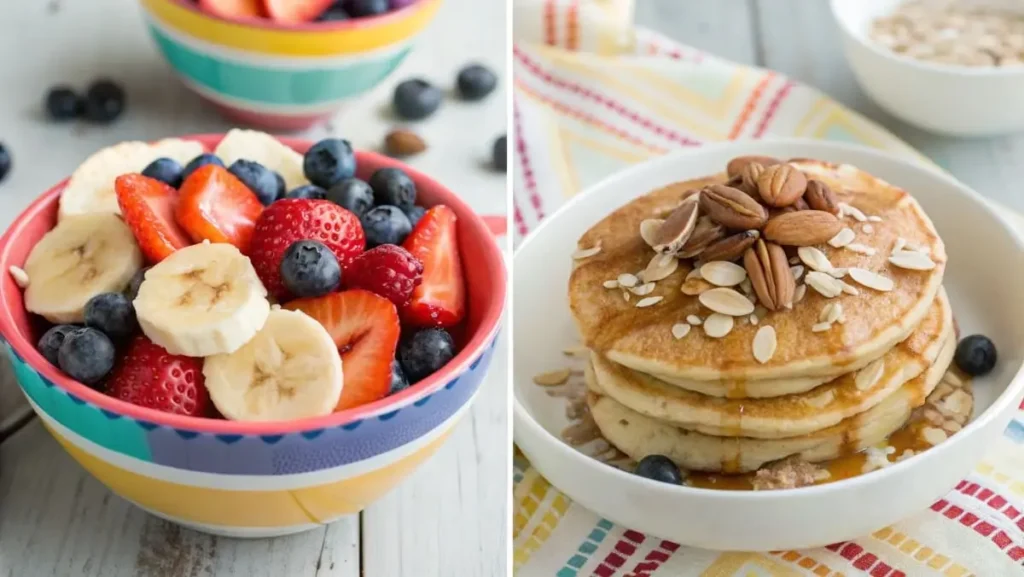
Start the day off right with these gluten-free breakfast winners, proving that gluten-free can be just as delicious and satisfying!
- Fluffy Gluten-Free Pancakes (Dairy-Free Option): Use a gluten-free pancake mix or make your own from scratch with a gluten-free flour blend. For dairy-free pancakes, use dairy-free milk (almond milk, oat milk). Top with fruit, syrup, dairy-free whipped cream, or chocolate chips for a customizable and delightful gluten-free breakfast treat.
- Gluten-Free Oatmeal with Fruit & Cinnamon (Naturally GF): Oatmeal (certified gluten-free) is a naturally gluten-free and nutritious breakfast option. Cook oatmeal with water or milk (dairy or non-dairy) and top with fresh or frozen fruit (berries, bananas, apples), cinnamon, a drizzle of maple syrup or honey, and a sprinkle of nuts or seeds (if nut-free is not needed). Versatile and customizable to individual preferences.
- Egg Muffins (Gluten-Free & Easily Customizable): Egg muffins are a fantastic make-ahead gluten-free breakfast option. Whisk eggs with milk (dairy or dairy-free) and add your favorite gluten-free and kid-friendly fillings: cooked ham or bacon crumbles, shredded cheese (dairy or dairy-free), chopped vegetables (bell peppers, spinach, onions – finely diced for picky eaters). Bake in muffin tins until set and cooked through. Perfect for meal prep and grab-and-go breakfasts.
- Gluten-Free French Toast Sticks (Fun Dipping Food): Transform gluten-free bread into fun French toast sticks! Cut gluten-free bread slices into strips, dip in French toast batter (eggs, milk or dairy-free milk, cinnamon, vanilla), and pan-fry or bake until golden brown and cooked through. Serve with syrup, fruit, or yogurt for dipping, making breakfast interactive and appealing.
- Breakfast Quinoa Bowls (Gluten-Free & Versatile): Quinoa is a gluten-free grain that makes a surprisingly delicious breakfast bowl. Cook quinoa with milk (dairy or dairy-free) and a touch of sweetener (maple syrup or honey). Top with fresh or frozen fruit, nuts or seeds (if nut-free is not needed), yogurt (dairy or dairy-free), and a sprinkle of cinnamon. Customizable and packed with protein and fiber.
Category 2: Dairy-Free Kid Friendly Lunches (5 Ideas)

Dairy-free lunches can be just as creamy, cheesy (using dairy-free alternatives!), and satisfying as their dairy-containing counterparts.
- Dairy-Free “Cheese” Quesadillas (Quick & Easy): Quesadillas are a lunch staple, easily made dairy-free! Use dairy-free cheese shreds (cheddar, mozzarella style) and fill tortillas with dairy-free cheese and other kid-friendly fillings: cooked chicken or beans, sautéed peppers and onions (finely diced), or just cheese for a simple version. Cook in a skillet or panini press until dairy-free cheese is melted and tortillas are golden brown. Serve with salsa or guacamole.
- Turkey & Avocado Roll-Ups (Naturally Dairy-Free & Portable): Simple, naturally dairy-free, and perfect for lunchboxes! Lay out slices of deli turkey breast and spread with a dairy-free cream cheese alternative or avocado mash. Add cucumber sticks, spinach leaves, or bell pepper strips for added veggies (optional). Roll up tightly and slice into pinwheels or serve whole.
- Dairy-Free Chicken Salad Lettuce Wraps (Light & Fresh): Make a creamy and delicious chicken salad using dairy-free mayonnaise or avocado mayo instead of traditional mayo. Combine cooked shredded chicken with dairy-free mayo, celery, grapes or cranberries, and seasonings. Serve chicken salad in crisp lettuce cups for a light, refreshing, and dairy-free lunch option.
- Dairy-Free Tomato Soup & “Grilled Cheese” (Comforting & Classic): Enjoy the classic combo, dairy-free! Make a creamy tomato soup using vegetable broth, canned tomatoes, and dairy-free cream (coconut cream or cashew cream) for richness. Serve with dairy-free “grilled cheese” sandwiches made with dairy-free cheese slices and dairy-free butter alternatives on bread (gluten-free if needed).
- Lentil Soup (Hearty & Naturally Dairy-Free): Lentil soup is a naturally dairy-free, hearty, and nutritious lunch option. Make a flavorful lentil soup with lentils, vegetable broth, diced vegetables (carrots, celery, onions, potatoes), and spices. Lentil soup is packed with protein and fiber and is a warming and satisfying dairy-free lunch, especially on cooler days.
Category 3: Nut-Free Kid Friendly Snacks (5 Ideas)
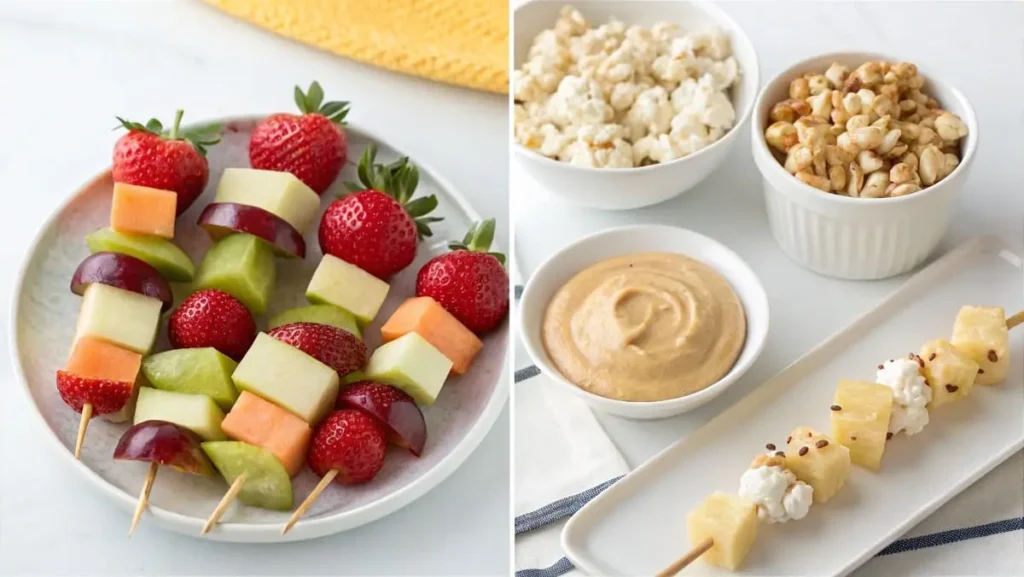
Snack time can be tricky with nut allergies. These nut-free snack ideas are safe, satisfying, and kid-approved!
- Fruit Skewers with Yogurt Dip (Nut-Free & Healthy): Naturally nut-free and packed with vitamins! Thread chunks of your child’s favorite fruits (grapes, melon, berries, kiwi, pineapple) onto skewers. Serve with a side of yogurt (dairy or dairy-free) for dipping. Yogurt dip adds protein and calcium (or calcium alternative in dairy-free yogurt) and makes fruit skewers more fun to eat.
- Seed Bars (Nut-Free Chewy Granola Bars): Make your own chewy and delicious granola bars using seeds instead of nuts! Use a base of sunflower seeds, pumpkin seeds, or a mix of seeds. Combine seeds with oats (certified gluten-free if needed), dried fruit (cranberries, raisins, chopped apricots), and a binder of honey or maple syrup and seed butter (sunflower seed butter or tahini). Bake until chewy and golden brown. A safe and satisfying nut-free snack bar.
- Popcorn (Naturally Nut-Free Whole Grain Snack): Popcorn is a naturally nut-free, whole-grain snack that kids often love. Air-pop popcorn for a healthier option and season with salt, nutritional yeast (for a cheesy flavor), cinnamon sugar (for a sweet treat), or other kid-friendly seasonings. Avoid pre-packaged microwave popcorn, which may contain butter or artificial flavorings and is often less healthy.
- Pretzel Bites with Hummus (Nut-Free Savory Snack): A simple and satisfying savory snack. Serve pretzel bites (check labels for nut-free pretzels if needed) with hummus (chickpea dip). Hummus is naturally nut-free and provides protein and fiber. Choose plain or roasted red pepper hummus for kid-friendly flavors.
- Edamame (Steamed or Roasted Nut-Free Protein Snack): Edamame (steamed or roasted soybeans in pods) is a fun and nutritious nut-free snack that’s packed with protein and fiber. Steam or roast edamame pods and sprinkle with salt. Kids enjoy popping the edamame beans out of the pods and eating them as a snack.
Category 4: Egg-Free Kid Friendly Dinners (5 Ideas)
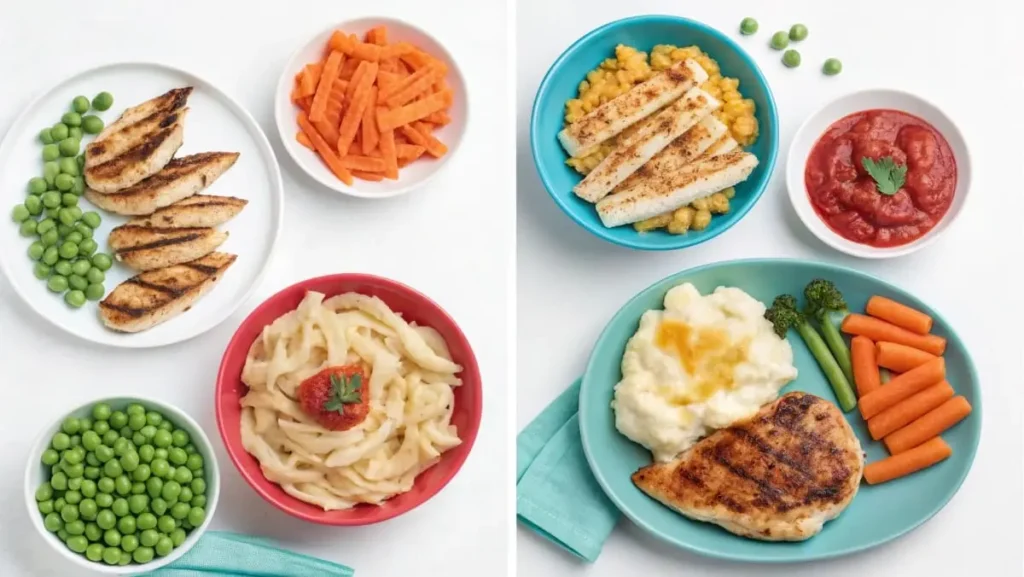
Egg-free dinners can be just as hearty, flavorful, and kid-approved as egg-containing meals!
- Egg-Free “Meatloaf” (Using Flax Egg or Other Binder): Enjoy classic meatloaf without the eggs! Use ground beef or turkey and substitute eggs with a flax egg (flaxseed meal and water) or other egg replacer as a binder. Load your egg-free meatloaf with finely chopped vegetables (onions, carrots, zucchini) and season with ketchup, Worcestershire sauce (check for egg-free), and spices. Bake until cooked through and serve with mashed potatoes (dairy-free if needed) or roasted vegetables.
- Pasta with Egg-Free “Meatballs” (Marinara Sauce): Spaghetti and meatballs, egg-free! Make egg-free meatballs using ground beef or turkey and breadcrumbs (whole wheat or panko). Use applesauce or mashed banana as a binder instead of eggs. Bake or pan-fry egg-free meatballs and serve over whole wheat pasta or gluten-free pasta with marinara sauce. A comforting and familiar egg-free dinner option.
- Sheet Pan Chicken & Veggies (Naturally Egg-Free & Customizable): Sheet pan dinners are naturally egg-free and easy to customize for kid preferences. Roast chicken pieces (boneless, skinless chicken breasts or thighs) with your child’s favorite low-carb vegetables (broccoli, bell peppers, carrots, sweet potatoes) on a sheet pan. Toss with olive oil, seasonings, and herbs for a simple and healthy egg-free dinner with minimal cleanup.
- Tofu Stir-Fry (Egg-Free Asian Inspired): Create a flavorful egg-free stir-fry using firm tofu (pressed and cubed) and low-carb vegetables like broccoli, snap peas, carrots, and mushrooms. Use a soy sauce alternative like coconut aminos or tamari and a stir-fry sauce thickened with cornstarch or arrowroot starch (instead of egg-based thickeners). Serve over rice or quinoa (if gluten-free is not needed) or cauliflower rice for a vegetarian and egg-free Asian-inspired meal.
- Black Bean Burgers (Egg-Free Vegetarian Protein): Make your own egg-free vegetarian black bean burgers! Mash cooked black beans and combine with breadcrumbs (whole wheat or panko), oats (certified gluten-free if needed), diced onions and peppers, and spices. Form into patties and bake or pan-fry until cooked through and slightly crispy. Serve on burger buns (whole wheat or gluten-free) with your child’s favorite burger toppings (cheese alternative if dairy-free needed, lettuce, tomato, avocado, ketchup, mustard).
Category 5: Allergy-Friendly Kid Friendly Desserts (5 Ideas)

Dessert can be allergy-friendly and still a treat! These recipes cater to multiple allergies while satisfying sweet cravings.
- Gluten-Free & Dairy-Free Chocolate Chip Cookies (Allergy-Friendly Classic): Everyone loves chocolate chip cookies! Make a batch of allergy-friendly cookies using a gluten-free flour blend and dairy-free butter alternative (vegan butter sticks or coconut oil). Add dairy-free chocolate chips for a classic and allergy-friendly dessert that’s sure to please.
- Fruit Crumble (Gluten-Free & Dairy-Free, Oat-Free Option): Fruit Crumble is a warm and comforting allergy-friendly dessert. Use a gluten-free and oat-free crumble topping made with a gluten-free flour blend, dairy-free butter alternative, and sugar. Top with your child’s favorite fruit filling: apples, berries, peaches, or a mix. Bake until the fruit is bubbly and topping is golden brown. Serve warm with dairy-free ice cream or coconut whipped cream (optional).
- “Nice Cream” (Banana-Based “Ice Cream” – Naturally Allergy-Friendly): “Nice cream” is a naturally dairy-free, nut-free, egg-free, and gluten-free “ice cream” made from frozen bananas! Simply blend frozen bananas in a food processor or high-speed blender until smooth and creamy like soft-serve ice cream. Add flavorings like vanilla extract, cocoa powder (for chocolate nice cream), or other fruit for endless allergy-friendly variations.
- Applesauce Cake (Egg-Free & Dairy-Free Adaptable): Applesauce cake can be made allergy-friendly with simple substitutions. Use applesauce instead of eggs as a binder and dairy-free milk and oil instead of dairy. Use a gluten-free flour blend for a gluten-free version. Spice with cinnamon and nutmeg for a warm and comforting allergy-friendly cake that’s perfect for dessert or a snack.
- Chia Seed Pudding (Naturally Allergy-Friendly & Versatile): Chia seed pudding is a naturally gluten-free, dairy-free, nut-free, and egg-free dessert (or snack) that’s packed with nutrition and easy to customize. Combine chia seeds with dairy-free milk (coconut milk, almond milk, oat milk), sweetener (maple syrup or honey), and vanilla extract. Refrigerate to thicken and enjoy chilled. Top with fruit, dairy-free chocolate chips, or cinnamon for added flavor and texture.
Category 6: Top 8 Allergen-Free (or Very Low Allergen) Kid Friendly Meals (5 Ideas)
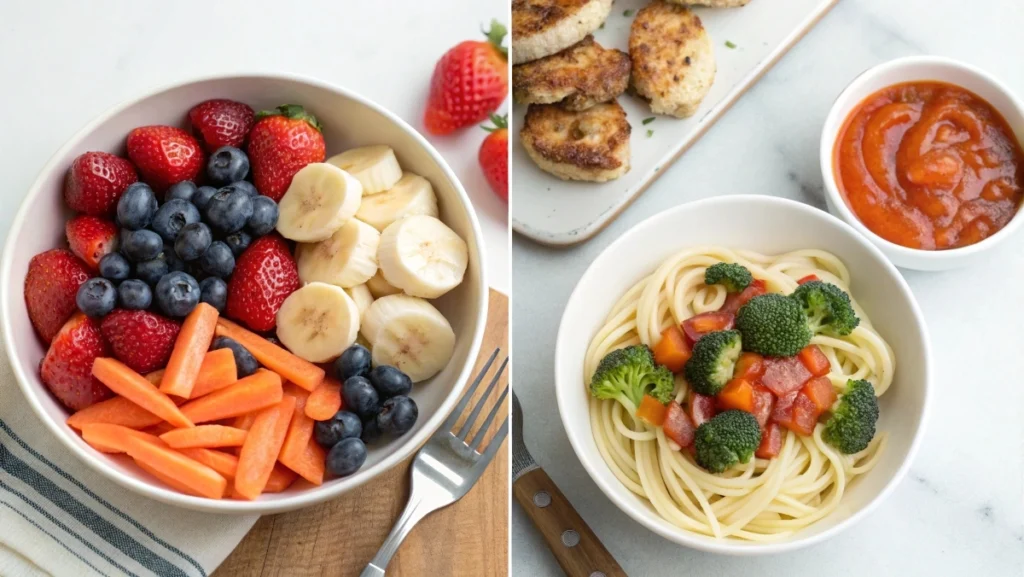
These recipes are designed to be as inclusive as possible, minimizing the risk of allergic reactions by being free from or very low in the Top 8 allergens. Always double-check labels and ingredient lists to ensure safety for your child’s specific allergies.
- Simple Roasted Chicken & Vegetables (Top 8 Allergen-Free): A naturally Top 8 allergen-free meal base! Roast chicken pieces (bone-in, skin-on) with a variety of vegetables that are safe for your child’s allergies (broccoli, carrots, sweet potatoes, zucchini, cauliflower, etc.). Toss with olive oil, salt, pepper, and herbs like rosemary or thyme for a simple, nutritious, and allergy-friendly dinner.
- Rice Noodles with Chicken & Veggies (Top 8 Free with Careful Sauce Selection): Rice noodles are naturally gluten-free and Top 8 allergen-free. Stir-fry rice noodles with chicken or tofu and Top 8 allergen-free vegetables (broccoli, carrots, bell peppers, snap peas, mushrooms). Use a carefully selected stir-fry sauce made with coconut aminos (soy-free soy sauce alternative), rice vinegar, ginger, garlic, and a touch of maple syrup or honey for sweetness, ensuring all sauce ingredients are Top 8 allergen-free.
- Lentil Soup (Naturally Top 8 Allergen-Free & Vegetarian Protein): Lentil soup is naturally Top 8 allergen-free, vegetarian, and packed with protein and fiber. Make a simple lentil soup with lentils, vegetable broth, diced carrots, celery, onions, and Top 8 allergen-free seasonings like salt, pepper, garlic powder, onion powder, and bay leaf. A warming, nourishing, and highly allergy-friendly meal.
- “Safe” Chicken and Rice Casserole (Adaptable for Top 8 Free): Casseroles can be adapted to be Top 8 allergen-free with careful ingredient selection. Use a base of cooked rice and shredded chicken. Create a creamy sauce using a base of vegetable broth thickened with tapioca starch or arrowroot starch and nutritional yeast for cheesy flavor (dairy-free). Add the Top 8 allergen-free vegetables like broccoli or green beans. Bake until bubbly and heated through. Double-check all ingredients for allergen safety.
- Baked Sweet Potatoes with Chili (DIY Toppings – Allergy-Friendly Customization): Baked sweet potatoes are a naturally Top 8 allergen-free base for a customizable meal. Bake sweet potatoes until tender and set up a topping bar with Top 8 allergen-free chili (vegetarian or meat-based), safe toppings like avocado, salsa, green onions, and roasted vegetables. Let everyone build their own loaded sweet potatoes, ensuring a safe and inclusive meal for all dietary needs.
Essential Tips for Cooking Kid Friendly Recipes for Special Diets
Label Reading is Your Superpower:
When cooking for kids with special diets, label reading is not just important – it’s your superpower! Meticulous label reading is essential to ensure the safety of your children, especially when managing food allergies.
- Read Every Label, Every Time: Always read ingredient labels every time you purchase a product, even if you’ve bought it before. Ingredients and manufacturing processes can change, and “safe” products can become unsafe without warning.
- Look for Allergen Statements: Carefully check for allergen statements like “Contains: Milk, Wheat, Soy, etc.” These statements are usually found near the ingredient list and list the Top 8 allergens present in the product.
- “May Contain” Warnings: Be aware of “may contain” or “processed in a facility that also processes” warnings. These indicate potential cross-contamination risks. For severe allergies, it’s generally recommended to avoid products with these warnings. Consult with your allergist or pediatrician for guidance on managing “may contain” warnings based on your child’s specific allergy severity.
- Hidden Names for Allergens: Learn to recognize hidden names for common allergens. For example, “whey” and “casein” indicate dairy, “albumin” indicates egg, and “hydrolyzed vegetable protein” can sometimes contain soy or wheat. Online resources and allergy organizations can provide lists of hidden allergen names.
Ingredient Substitutions & Swaps (Master the Basics):
Mastering ingredient substitutions is key to making special diet cooking successful and flavorful.
- Gluten-Free Flour Blends: Use commercially available gluten-free all-purpose flour blends designed for baking. These blends typically contain a mix of rice flour, starches, and binders to mimic the properties of wheat flour. Experiment with different brands to find your favorite.
- Dairy-Free Milk Alternatives: Explore a variety of dairy-free milk alternatives: almond milk, soy milk, oat milk, rice milk, coconut milk, cashew milk, etc. Each has a slightly different flavor and texture, so choose based on the recipe and your child’s preferences. Unsweetened varieties are generally recommended for cooking and baking to control sugar intake.
- Egg Replacers: For egg-free baking, common egg replacers include flax eggs (flaxseed meal mixed with water), applesauce, mashed banana, pumpkin puree, and commercial egg replacer powders. The best egg replacer depends on the recipe and desired texture.
- Nut-Free Butter Alternatives: For nut-free baking and cooking, use seed butter like sunflower seed butter or pumpkin seed butter instead of peanut butter or almond butter. For buttery flavor and texture in baking, use dairy-free butter alternative sticks (vegan butter sticks) or coconut oil.
To delve deeper into the world of gluten-free baking and learn essential techniques and recipes, explore our guide: The ultimate guide to gluten-free baking.
Preventing Cross-Contamination (Allergy Safety):
Preventing cross-contamination is paramount when cooking for children with food allergies, especially severe allergies. Even trace amounts of an allergen can trigger a reaction.
- Dedicated Cutting Boards & Utensils: Use dedicated cutting boards, knives, mixing bowls, and utensils that are only used for preparing special diet meals and are never used with allergenic ingredients. Color coding can be helpful to visually distinguish allergen-free equipment.
- Separate Cooking Equipment (If Possible): If possible, consider having dedicated cooking equipment like toasters, blenders, and cookware that are exclusively used for preparing allergen-free meals, especially for severe allergies or celiac disease.
- Thorough Cleaning & Sanitizing: Thoroughly clean and sanitize all countertops, cutting boards, utensils, cookware, and appliances with hot, soapy water before preparing special diet meals to remove any potential allergen residue. Dishwashers generally sanitize more effectively than hand washing.
- Wash Hands Frequently & Carefully: Wash your hands thoroughly with soap and water before and after handling any allergenic ingredients and before preparing any special diet meals. Handwashing is crucial to prevent allergen transfer.
- Read “May Contain” Warnings Seriously: As mentioned earlier, take “may contain” warnings seriously, especially for severe allergies. Avoid products with these warnings unless you have consulted with your allergist or pediatrician and they have advised otherwise based on your child’s specific allergy severity.
Making it Fun & Engaging (Even with Restrictions):
Even with dietary restrictions, mealtimes should still be fun and engaging for kids!
- Focus on Positives, Not Restrictions: Frame special diets in a positive light, focusing on all the delicious foods your child can eat rather than dwelling on what they can’t. Emphasize the deliciousness of special diet meals and the variety of flavors and textures they can enjoy.
- Get Creative with Presentation (as discussed earlier): Utilize all the visual appeal and fun presentation tips discussed earlier (fun shapes, colorful plates, interactive plating) to make special diet meals more exciting and less “different” in kids’ eyes.
- Involve Kids in Special Diet Cooking & Baking: Involve children in age-appropriate tasks when preparing special diet meals and treats. Let them help measure ingredients, stir batter, decorate cookies, or assemble their own “build-your-own” special diet creations. This can increase their interest in and acceptance of special diet foods.
- Celebrate Special Diet Successes: Celebrate your child’s successes in trying new special diet foods or mastering a new special diet recipe! Positive reinforcement and praise can go a long way in building confidence and making special diet eating a more positive experience.
FAQ: Your Top Questions About Kid Friendly Recipes for Special Diets Answered
- Q: Where can I find reliable kid friendly recipes for special diets?
- A: There are many excellent resources for kid friendly recipes for special diets! Look for reputable websites, blogs, and cookbooks dedicated to specific diets like gluten-free, dairy-free, nut-free, or allergy-friendly cooking. Allergy organizations (like FARE) and registered dietitians specializing in pediatric allergies or special diets can also be valuable sources of reliable recipes and information.
- Q: How can I make sure kid friendly recipes for special diets are still delicious?
- A: The key to delicious kid friendly recipes for special diets is to prioritize flavor! Use flavorful ingredient substitutions, bold seasonings and spices (kid-appropriate), and focus on adapting familiar kid-favorite recipes to be special diet-compliant. Don’t sacrifice taste for restrictions – experiment and find recipes that are both safe and delicious for your child.
- Q: Are kid friendly recipes for special diets more expensive to make?
- A: Kid friendly recipes for special diets can sometimes be slightly more expensive due to the cost of specialized ingredients like gluten-free flour blends or dairy-free alternatives. However, you can make special diet cooking more budget-friendly by: focusing on whole, unprocessed ingredients, utilizing affordable protein sources, buying ingredients in bulk when possible, and planning your meals to minimize food waste.
- Q: How do I adapt regular kid friendly recipes to be special diet compliant?
- A: Adapting regular kid friendly recipes for special diets involves understanding ingredient substitutions. Learn about common swaps for gluten, dairy, eggs, and nuts. Start with simple substitutions and gradually experiment with more complex adaptations. Online resources and special diet cookbooks often provide guides to ingredient substitutions and recipe conversions. When in doubt, start with recipes specifically designed for special diets, as they are often easier to follow and more likely to be successful for beginners.
- Q: What are the best resources for learning more about kid friendly recipes for specific special diets like gluten-free or dairy-free?
- A: For learning more about kid friendly recipes for specific special diets, explore online resources like: websites and blogs dedicated to gluten-free, dairy-free, nut-free, or allergy-friendly cooking; websites of reputable allergy organizations (like FARE); registered dietitians specializing in pediatric allergies or special diets often share recipes and tips on their websites or social media; and search for cookbooks specifically focused on kid-friendly special diet cooking in your local library or online booksellers.
Conclusion: Nourishing All Kids with Delicious & Safe Special Diet Meals!

Cooking for kids with special diets might seem challenging at first, but it’s absolutely achievable and incredibly rewarding! With the right knowledge, resources, and a little creativity, you can create kid friendly recipes that are not only safe and nutritious, but also utterly delicious and enjoyable for all children, regardless of their dietary needs. Embrace the journey of special diet cooking, use these recipes and tips as your guide, and discover the joy of nourishing all kids with inclusive and delicious meals that bring smiles to their faces and peace of mind to your heart. Happy (and safe!) cooking!
